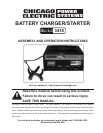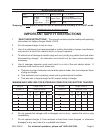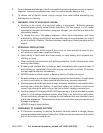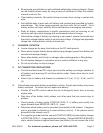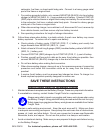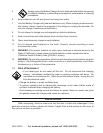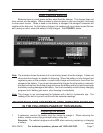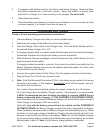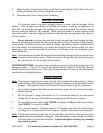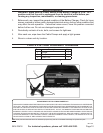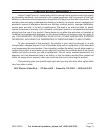Page 4SKU 03418 For technical questions, please call 1-800-444-3353.
Be sure area around battery is well ventilated while battery is being charged. Gases b.
can be forcefully blown away, by using a piece of cardboard or other non-metallic
material such as a fan.
Clean battery terminals. Be careful to keep corrosion from coming in contact with c.
eyes.
Add distilled water in each cell until battery acid reaches level specied by battery d.
manufacturer. This helps purge excessive gas from cells. Do not overll. For a
battery without cell caps, carefully follow manufacturer’s recharging instructions.
Study all battery manufacturer’s specic precautions such as removing or not e.
removing cell caps while charging and recommended rates of charge.
Determinate voltage of battery by referring to car owner’s manual and make sure f.
that output voltage selector switch is set at correct voltage. If charger has adjustable
charge rate, charge battery initially at lowest rate.
CHARGER LOCATION13.
Locate charger as far away from battery as the DC cable permits.a.
Never place charger directly above battery being charged; gases from battery will b.
corrode and damage charger.
Never allow battery acid to drip on charger when reading gravity or lling battery.c.
Do not operate charger in a closed-in area or restrict ventilation in any way.d.
Do not set a battery on top of charger.e.
DC CONNECTION PRECAUTIONS14.
Connect and disconnect DC output clips only after setting any charger switches to a.
off position and removing AC cord from electric outlet. Never allow clips to touch
each other.
Attach clips to battery and chassis as indicated in 15 (e), 15 (f), 16 (b), and 16 b.
(d).
Follow these steps when battery is installed in vehicle. A spark near battery may cause 15.
battery explosion. To reduce risk of a spark near battery:
Position AC and DC cords to reduce the risk of damage by hood, door, or moving a.
engine parts.
Stay clear of fan blades, belts, pulleys, and other parts that can cause injury to b.
persons.
Check polarity of battery posts. POSITIVE (POS, P, +) battery post usually has c.
larger diameter than NEGATIVE (NEG, N, -) post.
Determine which battery post is grounded (connected) to the chassis. If negative d.
post is grounded to chassis (as in most vehicles), see (e). If the positive post is
grounded to the chassis, see (f).
For negative-grounded vehicle, connect POSITIVE (RED) clip from battery charger e.
to POSITIVE (POS, P, +) ungrounded post of battery. Connect NEGATIVE (BLACK)
clip to vehicle chassis or engine block away from battery. Do not connect clip to the



